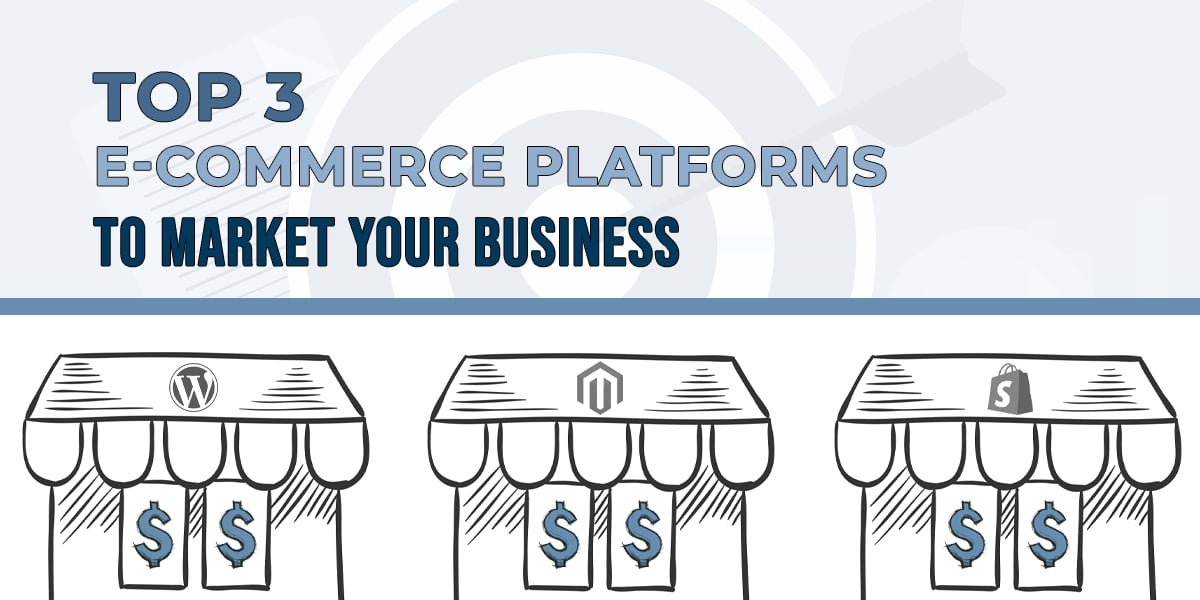Top 3 Ecommerce Platforms to Market Your Business
If you are considering entering the world of Ecommerce, you are without a doubt asking yourself: of all my options, which are the best platforms for my business? WordPress, or Shopify? Maybe Magento? In this article, we are going to break down which of these are the top 3 ecommerce platforms for sales growth, as well as other aspects of marketing. We’ll touch on many important features of Shopify, WordPress, and Magento to give you a better idea of which might be right for you.
Spoiler alert: We love them all! Stick around ‘til the end to see how you can make the right decisions for your business.
All About Shopify for Ecommerce Businesses
Shopify is the leading Ecommerce platform in the United States and many other countries. In fact, it holds 32% of the market share for Ecommerce platforms! It’s popular for a reason: Shopify makes Ecommerce simple and seamless for both merchants and consumers.
Let’s break down some of the main features of Shopify’s platform:
Pricing:
Pricing plans for Shopify can range from $29-299/month, with discounts if you opt for a year—or years-long billing plan. There is a 14-day free trial, but frankly, you will need more time than that to dial in all the details. On top of this, there is a small fee to use major credit cards as payment in your store.
Payments:
Shopify has its own payment provider, Shopify Payments. If you would rather use a third-party payment provider, Shopify requires a small transaction fee to cover the integration into its platform
Using Shopify Payments streamlines the checkout process for your customers, eliminates the fee for third-party payment processing and allows you to see your payment processing happening in real-time from within Shopify. It also helps retain customers in the buying process, because they do not have to leave the site to enter their info into another provider.
Design:
When it comes to page design, Shopify has created an intuitive and powerful array of customization options. There is no coding involved, with a wide variety of templates so you design without frustration. Now, if you do prefer to get your hands dirty, the coding is always available to merchants who want to dig a little deeper.
Email Marketing Tools:
Shopify has been in the game for a while now, and they understand the importance of extending your business through marketing. One great option they offer is integrated email marketing through the native client Shopify Email. All paying merchants are allowed 2,500 individual emails for free each month, and then are charged a small fee for further email campaigns.
Each email campaign can target up to 40,000 addresses, but there is an option to divide your lists into groups to expand your reach. Shopify also offers plenty of design options within their email client so you can make sure your marketing matches your brand.
Other Marketing & Conversion Tools:
A super cool feature that we love when it comes to Shopify is their slick “Shopcodes.” These are custom QR codes that you can send or print. Their use is customizable as well, they can be utilized for offering discounts, adding physical items to a shopping cart, giving out more product info, and more.
Shopify’s abandoned cart recovery feature helps you reclaim lost sales by saving carts with products that have been forgotten. This feature sends an email to the customer at certain intervals to remind them. This is a great marketing tool because it capitalizes on “warm leads” and reaches out in a friendly, helpful way.
Third-Party App Marketplace:
A really useful feature of the Shopify platform for merchants is the native app store. Through this, you can browse and install tools and programs to help you do more. This might include email marketing tools, social media logins, wishlist platforms, and much more.
Is WordPress a Good Choice For Your Ecommerce Business?
You may hear WordPress and think blogging… and you would be right. Nowadays though, the company has expanded its offerings to make its users’ sites Ecommerce-friendly. This has made it a formidable option when comparing platforms to host your business on. Let’s investigate the pros and cons.
Pricing:
You’re going to need either the Business or eCommerce plan, priced at $25 and $45 a month, respectively. Both are viable, but regardless you will find yourself installing the WooCommerce plugin very quickly. This is the main driver of Ecommerce on the WordPress platform, and for good reason. For one, it’s free! Two, it offers a wide variety of functionality for facilitating your business operations.
For this reason, we will mainly be referring to the functions of WooCommerce on the WordPress platform in this article.
Payments:
WooCommerce Payments is an amazing, native payment provider. It’s free to sign up and use, with no transaction fees. There are credit card fees though, with U.S. credit and debit cards fetching a 2.9% fee, and non-U.S. cards racking up a 3.9% fee.
Design:
WordPress is the resident boss of design. It’s been their forte for years! The company has over 8,000 themes to choose from for your site, and over 1,200 Ecommerce-focused templates, you can browse to make sure your site is crafted exactly how you and your customers will like it.
On top of this, the coding and other “backend” design options are readily available. In fact, it’s recommended that you have at least a very basic knowledge of how code works so that you can make small tweaks where you need them.
Email Marketing Tools:
WordPress doesn’t have any native email clients, but the wide range of options on the plugin store fills that void quite well. There are nearly too many to browse, but some popular ones are MailChimp, Newsletter, and Hubspot. These all integrate perfectly with the WordPress platform.
WooCommerce itself has an official plugin that you can download to facilitate your email campaigns. The WooCommerce Email Customizer is a tool that utilizes the WordPress design customizer to help you craft the perfect email.
Other Marketing & Conversion Tools:
WooCommerce is the portal to most other marketing tools that you’ll want to use on your WordPress site. Through WooCommerce, you can download and use a huge variety of tools for marketing.
A great example of this is the plugin Google Listings. This allows you to utilize Google’s shopping page to showcase your own products. It’s an official partner of WooCommerce and has the potential to boost your sales significantly.
Another prime marketing plugin is the official WooCommerce Points and Rewards tool, which can be used to incentivize current and past customers to become return buyers.
Is Magneto a Must-have for Ecommerce Business Marketing?
Magento is an open-source platform used by both small and large businesses to facilitate their Ecommerce operations. It’s a popular choice because of how customizable it is, as well as the scalability it offers. Let’s dive into Magento:
Pricing:
Magento’s platform comes in three main versions. The free, open-source version offers plenty of functionality and accounts for 83% of Ecommerce stores using Magento. It offers Integrated checkout, payment, and shipping as well as catalog management.
The lowest-level paid plan begins at $1,999 a month. The price tag represents plenty of functionality, though. It includes search engine optimization (SEO), free website monitoring tools, in-depth business analytics, and email support.
Payments:
Magento doesn’t do its own payment processing—you’ll need a third-party extension for that. This can be done either through Magento’s app store or by connecting your payments to an outside provider. Luckily, they allow you to use any payment provider you would like.
Design:
When it comes to design, Magento isn’t quite as forgiving as Shopify or WordPress. Between the three, it certainly is the most complex and requires a little more know-how to tweak things the way you like them.
There is a good collection of free and paid themes to begin working with, and there are template options available. Anything past that will necessitate some intermediate levels of coding knowledge.
Marketing & Conversion Tools:
Magento comes pre-built to handle multiple sales channels for driving conversion from different sources such as Google Ads. You can review performance and Return On Investment (ROI) numbers inside the platform.
It also comes with some hefty SEO tools for you to use, as well as Magento CMS to balance all your blogging needs. Magento’s other marketing features include creating coupons for multiple purposes, options for upselling, and offering promotional pricing.
Each paid level of Magento offers more robust marketing features, but even the base plan is quite extensive and customizable. Further tools can be found in its app store, or by upgrading your plan.
Making the Best Decisions For Your Website
At the end of the day, you need an Ecommerce platform that suits your needs, as well as your customers’. This means that it is essential to review and compare Shopify, WordPress, and Magento to determine what is truly the best for your ecommerce business. Making the best decision for your website means examining your target audience and your business strategy to see which platform offers the right setup for you.
Marketing an Ecommerce business is a complicated balancing act of strategy and engagement. For many business owners, having the experience and power of a professional marketing agency behind their backs is the key to supercharging their Ecommerce success.
Want to see how No to The Quo could help streamline and level up your marketing for your ecommerce business? We can even help you build out a stellar website design. Let’s chat about Ecommerce—we’ll even buy the coffee!
E-Commerce No To The Quo



